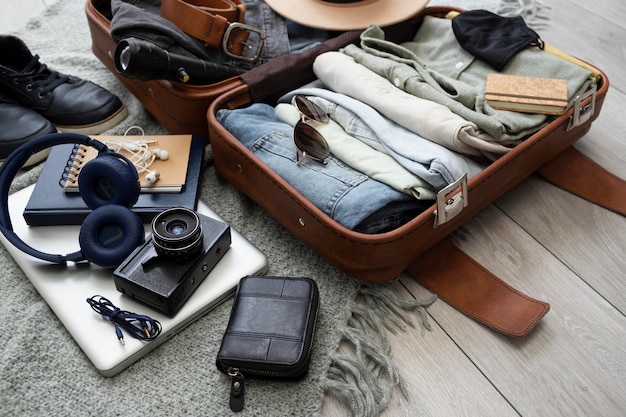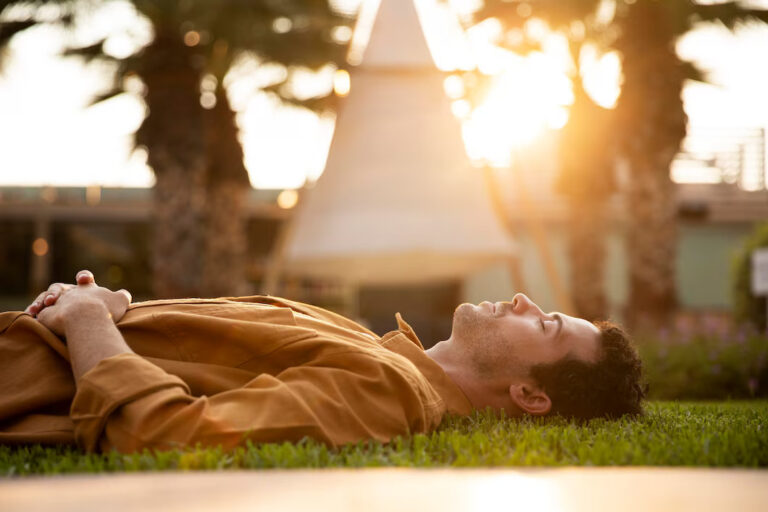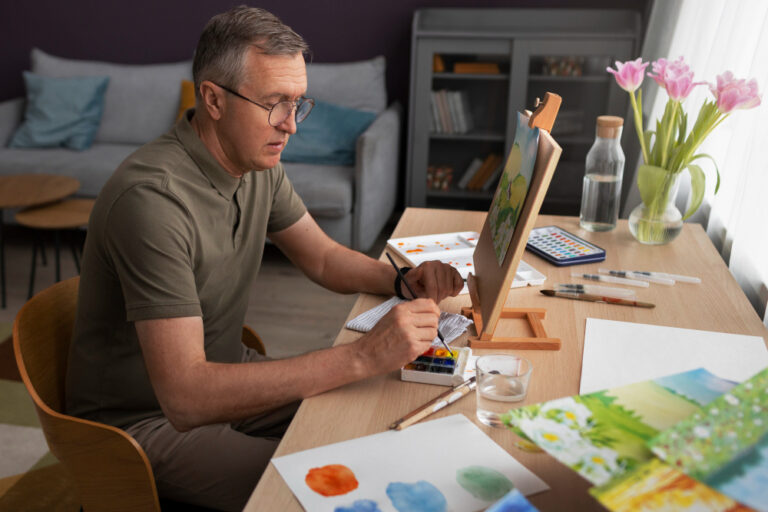
Imagine standing atop a mist-shrouded mountain pass. The air is crisp, carrying the scent of pine and damp earth. Birdsong echoes in the valley below. It’s a moment of pure awe, a scene painters dream of capturing. But instead of breathing it in, your first instinct is to pull out your phone check the signal, snap a picture for Instagram, maybe quickly reply to that work email that just pinged.
Sound familiar? In our hyper-connected world, the digital leash often follows us even to the most remote corners of the globe, subtly eroding the very presence and connection we seek when we travel. The constant buzz and glow pull us away from the vibrant reality in front of us, replacing authentic moments with filtered representations. This isn’t just about missing a photo opportunity; it’s about missing the experience itself.
This post is your guide to reclaiming your travels from the grip of technology. You’ll learn how to set healthy boundaries in digital conversations and interactions, paving the way for a truly immersive, mindful, and unforgettable journey. We’ll explore why disconnecting is so crucial, the profound benefits it unlocks, and practical strategies to leave the screens behind and step fully into the adventure awaiting you. Get ready to discover the richness of tech-free travel when experienced with all your senses, unmediated by a digital lens.
Setting Healthy Digital Boundaries in Digital Conversations
The Siren Song of Screens: Why We Struggle to Disconnect

Let’s be honest: detaching from our devices, especially while traveling, feels increasingly difficult. Why is the pull so strong? It’s a complex mix of ingrained habits, societal expectations, and sophisticated technological design aimed at capturing our attention.
We’ve become accustomed to instant gratification – immediate answers, constant social updates, endless entertainment streams. The fear of missing out (FOMO) becomes amplified when we’re away; we worry about falling behind at work, losing touch with friends and family, or missing some crucial piece of news.
Our smartphones have morphed into multi-tools we perceive as essential for travel: maps, cameras, translators, guidebooks, communication hubs. The convenience is undeniable, but it comes at a cost. Each notification, each ping, each reflexive check pulls our awareness away from the present moment.
Think about it: the vibrant chaos of a foreign market, the subtle shift of light on an ancient ruin, the quiet conversation with a fellow traveler – these nuanced experiences demand our full attention. When our focus is fragmented, split between the physical world and the digital realm, the depth of our experience diminishes. We might see the place, but do we truly feel it?
Furthermore, the digital world often presents a curated, idealized version of travel. Scrolling through perfect photos can create pressure to replicate those images rather than embracing the unpredictable, sometimes messy, reality of exploration. This constant comparison can subtly breed discontent, preventing us from appreciating the unique beauty of our own journey.
The habit of documenting everything can also shift our role from active participant to passive observer, experiencing the world through a screen rather than directly. Have you ever found yourself more focused on getting the ‘perfect shot’ than on simply savoring the view? Breaking free requires acknowledging these powerful pulls and making a conscious choice to prioritize presence over pings.
Key Points:
- Habit & FOMO: Ingrained digital habits and fear of missing out keep us tethered.
- Convenience Trap: Over-reliance on smartphones as all-in-one travel tools fragments attention.
- Diminished Presence: Constant digital interaction pulls focus from the immediate environment and authentic experiences.
- Comparison & Pressure: Social media can create unrealistic expectations and shift focus from experiencing to documenting.
The Unplugged Advantage: Rediscovering Presence and Joy

Choosing to disconnect, even partially, while traveling isn’t about deprivation; it’s about enrichment. The benefits of unplugging ripple through every aspect of your journey, transforming it from a series of checked boxes and captured photos into a deeply felt, memorable experience. Imagine the “before”: rushing through a museum, phone in hand, snapping pics while barely reading the descriptions, mind already jumping to the next notification.
Now, picture the “after”: walking slowly, truly seeing the brushstrokes on a canvas, feeling the cool marble beneath your fingers, absorbing the history without the digital buzz, maybe even striking up a conversation with a guide or fellow visitor. This is the power of presence.
When we silence the digital noise, our senses awaken. We notice the intricate patterns in a cobblestone street, the specific aroma of spices wafting from a food stall, the warmth of the sun on our skin, the cadence of a foreign language spoken around us.
Our minds, freed from constant multitasking, become calmer, more observant, and more receptive to the subtleties of our surroundings. This heightened awareness fosters a deeper connection to the place and its culture.
Research suggests that reducing screen time can lower stress levels, improve sleep quality (especially crucial when adjusting to new time zones), and enhance cognitive functions like memory and focus. You’re more likely to remember the details of a conversation, the taste of a local dish, or the feeling of a place when your mind isn’t cluttered with digital debris.
Moreover, disconnecting often leads to more authentic human interactions. Without the screen as a shield or distraction, we become more approachable and more inclined to engage with others – asking for directions, sharing a table at a café, learning a few words of the local language.
These spontaneous connections are often the most cherished travel memories. Think of it like switching from a pixelated digital image to a high-definition, sensory-rich reality. Which experience would you rather have? “Presence is the currency of memorable travel.”
How to Set Healthy Boundaries in Digital Conversations While Traveling

Actively setting healthy boundaries in digital conversations is the cornerstone of a mindful, tech-reduced travel experience. It’s not necessarily about going completely cold turkey (unless you want to!), but about consciously deciding when, how, and if you engage digitally, ensuring technology serves your trip rather than dictates it. This requires intention and clear communication, both with yourself and with others.
First, communicate your intentions before you leave. Let your workplace, family, and close friends know about your travel plans and your desired level of connectivity. Be specific. Instead of a vague “I’ll be hard to reach,” try: “I’ll be traveling from [start date] to [end date] and plan to be largely disconnected to fully immerse myself in the experience. I will check messages briefly once every three days around [specific time] for urgent matters only. For emergencies, you can try contacting [Hotel Name/Emergency Contact].” Setting these expectations upfront manages others’ assumptions and reduces the pressure you might feel to be constantly available. Utilize out-of-office replies for email and consider updating your voicemail message.
Second, define your own rules for digital engagement during the trip and commit to them.
- Designate Tech Times/Zones: Decide on specific, limited times for checking messages (e.g., 15 minutes in the evening) or specific places where tech is off-limits (e.g., no phones during meals, hikes, or cultural site visits). Treat these boundaries like important appointments.
- Curate Your Digital Tools: Do you really need all those social media apps? Temporarily delete the most distracting ones. Turn off non-essential notifications – do you need breaking news alerts or social media likes while exploring a new city? Probably not.
- Practice the Pause: When the urge to check your phone arises (and it will!), take a deep breath. Ask yourself: Is this necessary right now? What am I potentially missing in my immediate surroundings by looking down? Often, the urge passes if you simply acknowledge it without acting on it.
- Prioritize Face-to-Face: Make a conscious effort to engage with your travel companions or locals instead of retreating into your device during downtime.
Setting these boundaries isn’t about being rigid; it’s about being mindful. It’s about reclaiming your time and attention for the reasons you chose to travel in the first place – discovery, connection, and rejuvenation. Ask yourself: What kind of experience do I truly want to have on this trip?
Practical Strategies for a Screen-free Adventure

Moving beyond setting communication boundaries, let’s look at practical ways to minimize screen dependency throughout your travels. The goal is to create an environment where disconnecting feels natural rather than like a constant battle of willpower. It starts with preparation and continues with conscious choices during your journey.
One of the simplest yet most effective strategies is to physically separate yourself from your devices. Leave your smartphone, tablet, or laptop locked in your hotel safe or deep within your bag when you go out exploring. If you’re worried about emergencies, consider carrying a basic “dumb phone” with limited capabilities, purely for calls or texts if absolutely necessary. The mere absence of the device removes the temptation and forces you to engage more directly with your environment.
Embrace strategic use of Airplane Mode. Even if you keep your phone with you (perhaps for offline maps or as an emergency camera), keeping it consistently in Airplane Mode prevents notifications and the habitual checking of connectivity. You remain in control of when you choose to connect, rather than being reactively pulled in by the device. Similarly, turn off all non-essential notifications – email, social media, news alerts, game updates. Let your phone be a tool you consult intentionally, not a constant source of interruption.
Cultivate non-digital forms of engagement and entertainment. Pack physical books or an e-reader with pre-loaded content (less distracting than a multi-functional tablet). Bring a journal and pen to document your experiences, sketch scenes, or simply reflect. Carry a deck of cards or a small travel game for downtime or interacting with fellow travelers. I remember a trip through rural Vietnam where a simple deck of cards led to an unforgettable evening of laughter and connection with locals at a guesthouse, something that never would have happened if we’d all retreated to our phones. Focus on activities that inherently pull you into the present moment: mindful walking, focusing on your breath, engaging your senses, trying a local craft, or simply sitting on a bench and people-watching without an agenda.
Key Points:
- Physical Separation: Leave devices behind when possible.
- Airplane Mode & No Notifications: Control connectivity and minimize interruptions.
- Analog Entertainment: Pack books, journals, cards, games.
- Mindful Activities: Engage in practices that ground you in the present.
Analog Alternatives: Thriving Without the Tech Tether

A major hurdle for many considering tech-free travel is the perceived reliance on technology for essential functions like navigation, photography, and information gathering. However, embracing analog alternatives not only frees you from the screen but often enriches the travel experience in unexpected ways.
Let’s break down common tech dependencies and their analog counterparts:
- Navigation:
- Tech: GPS apps, online maps.
- Analog: Physical maps! Rediscover the joy and skill of map reading. Plotting your route on paper beforehand, using landmarks, and understanding the geography fosters a much deeper connection to the place. Add a compass for more remote adventures. Crucially, ask locals for directions. This simple act opens doors to conversation, insider tips, and a more human experience of navigating a new place. Getting slightly lost can even lead to wonderful, serendipitous discoveries!
- Photography:
- Tech: Smartphone camera, digital camera (often leading to obsessive capturing and immediate review/sharing).
- Analog: Disposable or film cameras. The limited number of shots encourages more thoughtful composition. The delayed gratification of waiting for prints adds anticipation and shifts focus from instant sharing to savoring the moment itself. Alternatively, sketching or journaling your observations creates a deeply personal and unique record of your experience, engaging your senses far more than snapping a quick photo. Try describing a scene in vivid detail in your journal instead of photographing it.
- Communication:
- Tech: Instant messaging, social media updates, video calls.
- Analog: Postcards! A wonderfully nostalgic way to share your journey with loved ones. Pre-arrange limited check-in times using landlines if necessary. Focus on face-to-face conversations with travel companions and locals. Learn a few basic phrases in the local language – it goes a long way.
- Information & Planning:
- Tech: Travel blogs, review sites, online booking platforms.
- Analog: Physical guidebooks. Often well-researched and curated. Visit local tourist information centers for maps, brochures, and personalized advice. Talk to hotel staff, guesthouse owners, and fellow travelers for recommendations. Embrace spontaneity rather than rigidly planning every minute based on online reviews.
- Entertainment:
- Tech: Streaming services, mobile games, social media scrolling.
- Analog: Books, journals, sketchpads, cards, travel board games. Engaging in conversation, people-watching, mindful observation, stargazing, or simply resting and letting your mind wander.
Tech-free Activites Guide:
- Go for a mindful walk, focusing only on the sensations of your feet on the ground and the sights/sounds around you.
- Spend an hour in a park or café simply observing, without any device. Note the interactions, the atmosphere.
- Visit a local market and try to identify unfamiliar smells or ingredients.
- Attempt to navigate a small area using only a paper map and landmarks.
- Write a detailed description of a place or experience in a journal instead of taking a photo.
- Learn and practice saying ‘hello,’ ‘thank you,’ and ‘goodbye’ in the local language.
Embracing these analog tools and activities transforms travel from a task to be efficiently managed by tech into an adventure to be savored and discovered.
Common Concerns & Solutions

The idea of traveling without the constant safety net of technology can understandably spark some anxieties. Let’s address the most common fears and offer practical, tech-light solutions:
- Concern: “What if there’s an emergency? How will I call for help or contact family?”
- Solution: Inform someone reliable back home of your detailed itinerary, including accommodation details. Carry a physical card with emergency contact numbers (yours and theirs) and local emergency service numbers. Know how to use hotel landlines or public phones if needed. For remote areas, consider investing in a dedicated Personal Locator Beacon (PLB) or satellite messenger (which have specific, limited functions for emergencies, distinct from smartphones). Traveling with a companion also adds a layer of security.
- Concern: “I’ll get hopelessly lost without GPS!”
- Solution: Embrace analog navigation (maps, compass) as discussed earlier. Learn basic map reading skills before you go. Ask locals for directions – it’s effective and fosters interaction. Reframe “getting lost” occasionally as part of the adventure, often leading to unexpected discoveries. Stick to well-trodden paths if you’re truly uncomfortable.
- Concern: “I’ll miss important news or updates from home/work.”
- Solution: Set clear expectations before leaving. Most non-emergency updates can wait. If absolutely necessary, schedule very brief and infrequent check-ins using Wi-Fi at your accommodation or an internet café, sticking strictly to your time limit. Trust that the world will keep turning without your constant oversight for a short period.
- Concern: “Won’t I be bored without my phone for entertainment?”
- Solution: Reframe “boredom” as “opportunity.” It’s a chance for your mind to rest, wander, observe, and reflect. Pack analog entertainment (books, journals, cards). Engage more deeply with your surroundings or travel companions. Often, the moments we perceive as “boring” are when our best insights or most creative ideas emerge. See the Tech-Free Activity Guide above for inspiration.
- Concern: “How will I capture memories without my smartphone camera?”
- Solution: Focus on experiencing and making memories, not just digitally documenting them. Use analog methods like film/disposable cameras, sketching, or journaling. Trust your own memory – studies show that not photographing something can sometimes lead to remembering it more vividly. The goal is a rich internal experience, not just a full camera roll.
Addressing these concerns proactively can build confidence and make the prospect of unplugging feel less daunting and more exciting.
Before You Go: Your Tech-free Prep Checklist

Setting yourself up for a successful tech-light or tech-free trip begins before you even lock your front door. A little preparation goes a long way in making the transition smoother and more enjoyable.
- Communicate Your Plan: Inform key contacts (work, family, friends) about your travel dates and your intention to disconnect or limit digital contact. Provide emergency contact information (like hotel numbers) if applicable.
- Set Up Auto-Responders: Activate ‘out of office’ messages for your email accounts, clearly stating your limited access and return date.
- Master Your Maps: Purchase physical maps of your destination(s). Spend some time familiarizing yourself with them before you leave. Practice basic map reading if needed. Consider packing a compass, especially for hiking.
- Download Offline Resources (Minimalist Backup): If keeping a phone purely for emergency backup or offline map access, download necessary maps or guidebook sections beforehand so you don’t need data/Wi-Fi. But prioritize paper!
- Pack Analog Entertainment: Choose physical books, a journal and pens/pencils, a sketchbook, a deck of cards, or small travel games.
- Pack Analog Tools: Include a reliable watch (don’t rely on your phone for time!), physical copies of important documents (tickets, reservations, contacts), a phrasebook if needed, and perhaps a disposable or film camera.
- Charge (then Ignore): If taking devices for emergencies, ensure they are fully charged. Then, mentally commit to leaving them off and packed away unless absolutely necessary.
- Digital Declutter: Temporarily delete highly distracting apps (social media, news, games) from your phone or move them off your home screen to reduce temptation. Turn off non-essential notifications.
- Set Your Intention: Take a moment to consciously decide why you want to disconnect and what you hope to gain. Remind yourself of this intention during your travels.
Reclaim Your Adventures, Rediscover Yourself

Traveling in the digital age presents a paradox: we have unprecedented access to information and connection, yet we risk experiencing less of the world in a truly meaningful way. The constant lure of the screen can create a barrier between us and the vibrant, unpredictable, sensory-rich reality of being in a new place. Setting healthy boundaries in digital conversations and consciously choosing to unplug is not about rejecting technology, but about reclaiming our attention and prioritizing authentic experience.
By stepping away from the constant stream of notifications and curated feeds, we open ourselves up to deeper connections – with the places we visit, the people we meet, and ultimately, with ourselves.
We trade the fleeting dopamine hit of a ‘like’ for the lasting joy of a spontaneous conversation, the perfect Instagram shot for the imperfectly beautiful memory etched in our minds, the convenience of GPS for the thrill of discovery found off the beaten path. We learn to trust our senses, embrace serendipity, and find richness in presence.
The world is vast, beautiful, and infinitely more fascinating than what can be contained within a glowing rectangle. Don’t let your adventures be lived through a screen.
Your challenge: On your next trip, whether it’s a weekend getaway or a month-long expedition, try implementing just one or two of these strategies. Leave your phone in the room for an entire day. Navigate using only a paper map. Strike up a conversation with a stranger instead of scrolling. Experience the difference. You might just discover that the greatest connections are made when you disconnect.




